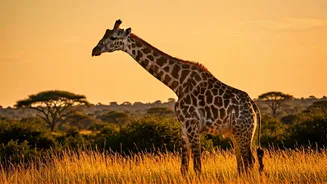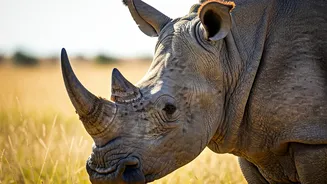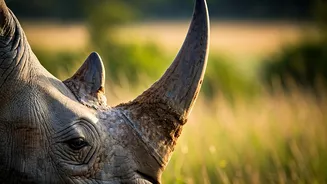Neck and Spine
Giraffes possess a surprisingly unique anatomical feature: their necks, despite being exceptionally long, only contain seven vertebrae – the same number
as humans! Each vertebra, however, can stretch up to 11 inches. This extraordinary length allows giraffes to reach high into trees for food, giving them a significant advantage over other herbivores. Their necks are also incredibly strong, weighing up to 500 pounds, which is a testament to the skeletal structure and the powerful muscles and ligaments that support the head's weight. These adaptations showcase how evolution has shaped the giraffe's form for survival in its environment.
Heart Powerhouse
The cardiovascular system of a giraffe is quite extraordinary to manage the massive size of the animal, particularly its elongated neck. Giraffes have an enormously powerful heart, weighing about 24 pounds, which is required to pump blood up such a long distance to the brain. To deal with the sudden changes in blood pressure, giraffes have various adaptations such as tight skin and a complex network of blood vessels. When a giraffe lowers its head to drink, a network of valves prevents blood from rushing into the brain, causing a potentially fatal pressure increase. These intricate systems highlight the biological marvels that enable giraffes to thrive in their unique niche.
Spots Galore!
Giraffe spot patterns are as individual as human fingerprints, enabling researchers to identify and study different giraffe populations. These spots provide camouflage, blending the animals with the dappled light and shadow of their surroundings. Furthermore, the size, shape, and color of the spots vary according to the giraffe's subspecies and also the age. Calves are born with spots that are typically lighter, gradually darkening as they mature. The intricate patterns also seem to act as heat-regulating mechanisms, with darker spots absorbing more sunlight. These unique spot formations highlight the diversity and adaptability of giraffes across different habitats.
Sleeping Habits
Giraffes do not spend much time sleeping, and they often only require about 30 minutes of sleep in a 24-hour period. Interestingly, they often sleep standing up, which helps them escape danger quickly. When they do lie down, they fold their legs beneath them. The most remarkable aspect of their sleeping behavior is that they may sleep for just a few minutes at a time, allowing them to remain vigilant. These unique sleep habits are vital for survival in their natural environment, where they are vulnerable to predators. Their ability to catch a few short naps highlights their evolved strategies to strike a balance between rest and vigilance.
Tongue Power
Giraffes have incredibly long tongues, averaging around 18-20 inches, which they use to strip leaves off trees and to groom themselves. Their tongues are not only long but also tough, with a prehensile ability, which means they can grasp things like the branches of trees. Moreover, the tongue is dark blue or purple, which scientists believe protects it from sunburn. They use their tongues to navigate the thorny branches of acacia trees, pulling leaves into their mouths while avoiding injuries. Their tongues' color and strength are essential adaptations for accessing food that is inaccessible to other herbivores.
Social Structures
Giraffes live in loose, open social structures which are commonly known as 'societies,' rather than in structured herds. They can often be seen in small groups, sometimes with males, but often mixing together without rigid hierarchies. Giraffes show various social behaviors, including friendly necking, where they rub their necks together, seemingly bonding. However, males compete for dominance by 'necking' during which they use their necks as weapons. The social dynamics of giraffes reveal a complex web of interactions that affect mating, safety, and access to resources.
Giraffe Calf Growth
A giraffe calf stands up and starts walking within an hour of birth, a crucial adaptation for survival. Calves are born with spots and a relatively compact appearance, making them somewhat similar to their parents. They are vulnerable to predators, which is why they are often concealed by their mothers within herds for the initial few weeks. Giraffe calves rely on their mothers for protection, feeding, and social learning for the first 16 months of their lives. The rapid development and early independence of giraffe calves highlight the pressures of life in the wild and the strategies that giraffes have developed to help their young survive.
Drinking Strategies
Giraffes have a unique stance to drink water, spreading their front legs wide and lowering their heads to reach the water, making them vulnerable to predators. It's a tricky maneuver because of the long neck and the high blood pressure needed to pump blood to their brain. To address this, they have a complex system of valves in their neck veins, allowing them to drink safely. Giraffes can go for days or even weeks without drinking, as they derive much of their moisture from the plants they eat. When they do drink, they drink in a slow and cautious manner, always staying alert for potential threats.
Conservation Status
Giraffes are listed as vulnerable on the IUCN Red List, facing various threats, including habitat loss, poaching, and conflicts with humans. Their populations have declined significantly in recent decades. Conservation efforts now aim to protect giraffe habitats, reduce human-wildlife conflicts, and combat poaching. These efforts include establishing protected areas, promoting sustainable tourism, and educating local communities about the importance of protecting giraffes. There's a concerted global focus on protecting these magnificent creatures for future generations.










